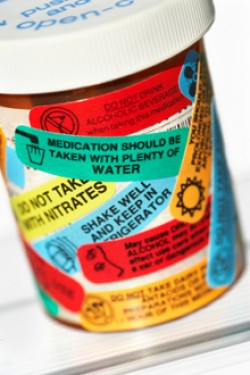Computer Method Predicts Drug Side Effects
Computer Method Predicts Drug Side Effects
Researchers have used computer modeling to predict the side effects of hundreds of medications. The technique could aid in the future development and use of drugs.

Medications can interact with many proteins in the body, not just the ones they’re targeted to. Unintended molecular interactions can cause side effects ranging from mild to serious. The ability to predict these side effects in advance would help doctors develop strategies to avoid or counteract them. But anticipating what side effects a drug could have in the body has been a daunting task.
A research team led by Dr. Brian K. Shoichet at the University of California, San Francisco, and Dr. Laszlo Urban at the Novartis Institutes for BioMedical Research developed a new approach to predict the potential side effects of a drug. They used a computational method called the similarity ensemble approach to calculate, based on chemical structure, what molecules a drug might bind to in the body. For reference, the scientists used a large database of drug-like molecules and the human proteins that they are known to interact with. The study was funded in part by NIH’s National Institute of General Medical Sciences (NIGMS) and National Institute on Aging (NIA). Their report appeared online on June 10, 2012, in Nature.
The researchers selected 656 drugs that have been approved for human use and 73 proteins that are known targets for adverse drug reactions. Using the similarity ensemble approach, they calculated how likely each drug was to bind to the 73 targets. The approach predicted about 1,600 potential interactions among the more than 47,000 possible drug—target pairs. Over 400 of the predicted interactions were previously known. Almost 350 more were found in proprietary Novartis databases.
The researchers tested about 700 of the remaining predictions experimentally at Novartis. The tests confirmed 151 of the predicted interactions, while another 65 were found to be ambiguous. To assess the clinical significance of the newly confirmed interactions, the researchers compared them with data on over 2,700 drugs, their known targets and any reported side effects. The team found that 82 of the 151 new drug—target associations were significantly associated with at least one side effect. In total, they identified almost 250 links to drug—target side effects. Many of the links were stronger than any previously known and sometimes provided better explanations for certain observed side effects.
“The biggest surprise was just how promiscuous the drugs were, with each drug hitting more than 10% of the targets, and how often the side-effect targets were unrelated to the previously known targets of the drugs,” Shoichet says. “That would have been hard to predict using standard scientific approaches.”
While the new method can’t replace laboratory testing, it could identify problems early in the drug development process. “This basically gives you a computerized safety panel, so someday, when you’re deciding among hundreds of thousands of compounds to pursue, you could run a computer program to prioritize for those that may be safest,” says Dr. Michael Keiser, a lead author of the paper.
In addition to helping streamline drug development, this approach could also help researchers find new uses for existing drugs.
By Harrison Wein, Ph.D.
###
* The above story is reprinted from materials provided by National Institutes of Health (NIH)
** The National Institutes of Health (NIH) , a part of the U.S. Department of Health and Human Services, is the nation’s medical research agency—making important discoveries that improve health and save lives. The National Institutes of Health is made up of 27 different components called Institutes and Centers. Each has its own specific research agenda. All but three of these components receive their funding directly from Congress, and administrate their own budgets.



















